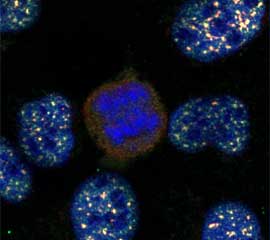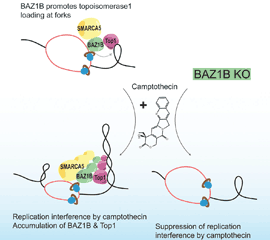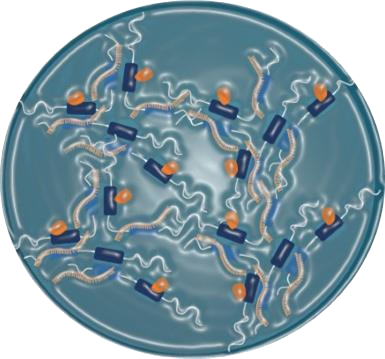Spatial organization and functions of Chk1 activation by TopBP1 biomolecular condensates
Tom Egger, Laura Morano, Marie-Pierre Blanchard, Jihane Basbous, Angelos Constantinou
Molecular bases of human diseases
DNA repair mechanisms are crucial for organismal health and survival. Therefore, all living organisms have evolved diverse mechanisms to repair alterations in the primary structure of DNA. Inherited defects in the mechanisms of genome maintenance is the underlying cause of cancer prone disorders such as Fanconi anemia, a disease characterized by defects in the repair of inter-strand DNA crosslinks and in the rescue of stalled replication forks. Furthermore, metabolic rewiring associated with carcinogenesis induces DNA lesions. Therefore, cancer cells rely on DNA damage responses to sustain growth in the presence of a high load of endogenous lesions and during chemotherapeutic treatments.
Our objective is to understand the biochemical mechanisms that underpin cellular responses to DNA lesions. These mechanisms are determinants for tumor growth and resistance to chemotherapies. We have analyzed systematically the protein composition of replication sites in basal conditions and in response to a variety of chemotherapeutic agents to identify proteins that ensure the progression of replication forks.
In recent years, our main focus has been on the mechanisms and functions of compartmentalization in the DNA damage response (DDR). Proteins required for the detection, the signaling and the repair of DNA lesions typically accumulate within distinct nuclear sites visualized as foci by immunofluorescence staining. We consider DDR nuclear foci as membrane-less compartments that control the spaciotemporal organization of DNA damage responses.
Our working model is that the recruitment of a key multivalent protein scaffolds at DNA lesions nucleates the assembly of DDR foci. Foci formation is triggered by posttranslational modifications that increase attractive interactions. These cooperative and reversible interactions promote the formation of micron-sized protein networks that fulfill the functions of subcellular compartments. For example, we reported recently that the multivalent protein scaffold TOPBP1 drives the assembly of nuclear foci to activate ATR/Chk1 signaling.
We use a combination of molecular biology, biochemistry, optogenetics and high-resolution microscopy to understand the mechanisms, the internal organization and the functions that arise specifically from the assembly of membrane-less compartments in the DDR.
Tom Egger, Laura Morano, Marie-Pierre Blanchard, Jihane Basbous, Angelos Constantinou
ALGHOUL Emile, BASBOUS Jihane, CONSTANTINOU Angelos
Emile Alghoul, Matteo Paloni, Arato Takedachi, Serge Urbach, Alessandro Barducci, Pierre-Henri Gaillard, Jihane Basbous, Angelos Constantinou
Ovejero S, Viziteu E, Dutrieux L, Devin J, Lin YL, Alaterre E, Jourdan M, Basbous J, Requirand G, Robert N, de Boussac H, Seckinger A, Hose D, Vincent L, Herbaux C, Constantinou A, Pasero P, Moreaux J
+
Epigenome modifications and genomic instability in normal and malignant B cells
Domagoj Vugic, Isaac Dumoulin, Charlotte Martin, Anna Minello, Lucia Alvaro-Aranda, Jesus Gomez-Escudero , Rady Chaaban , Rana Lebdy , Catharina von Nicolai , Virginie Boucherit , Cyril Ribeyre , Angelos Constantinou, Aura Carreira
Alghoul E, Basbous J, Constantinou A
Frattini C, Promonet A, Alghoul E, Vidal-Eychenie S, Lamarque M, Blanchard MP, Urbach S, Basbous J, Constantinou A
Basbous J, Aze A, Chaloin L, Lebdy R, Hodroj D, Ribeyre C, Larroque M, Shepard C, Kim B, Pruvost A, Moreaux J, Maiorano D, Mechali M, Constantinou A
+
Genetic Instability and Cancer
Basbous J, Aze A, Chaloin L, Lebdy R, Hodroj D, Ribeyre C, Larroque M, Shepard C, Kim B, Pruvost A, Moreaux J, Maiorano D, Mechali M, Constantinou A
+
Genetic Instability and Cancer
Basbous J, Constantinou A
Kumbhar R, Vidal-Eychenié S, Kontopoulos DG, Larroque M, Larroque C, Basbous J, Kossida S, Ribeyre C, Constantinou A
+ IMGT® - the international ImMunoGeneTics information system®
Viziteu E, Klein B, Basbous J, Lin YL, Hirtz C, Gourzones C, Tiers L, Bruyer A, Vincent L, Grandmougin C, Seckinger A, Goldschmidt H, Constantinou A, Pasero P, Hose D, Moreaux J.
+
Maintenance of genome integrity during DNA replication

Moriel-Carretero, M., Ovejero, S., Gerus-Durand, M., Vryzas, D., Constantinou, A.

Ribeyre C, Zellweger R, Chauvin M, Bec N, Larroque C, Lopes M, Constantinou A
Alsafadi S, Houy A, Battistella A, Popova T, Wassef M, Henry E, Tirode F, Constantinou A, Piperno-Neumann S, Roman-Roman S, Dutertre M, Stern MH
Bret C, Klein B, Cartron G, Schved JF, Constantinou A, Pasero P, Moreaux J.
Laguette,N., Bregnard, C., Hue, P., Basbous, J., Yatim, A., Larroque, M., Kirchhoff, F., Constantinou, A., Sobhian, B., Benkirane, M.
+
Laboratory of Molecular Virology
+
Kassambara A, Gourzones-Dmitriev C, Sahota S, Rème T, Moreaux J, Goldschmidt H, Constantinou A, Pasero P, Hose D, Klein B
Gourzones-Dmitriev C, Kassambara A, Sahota S, Rème T, Moreaux J, Bourquard P, Hose D, Pasero P, Constantinou A, Klein B.
+
Maintenance of genome integrity during DNA replication
Lossaint G, Larroque M, Ribeyre C, Bec N, Larroque C, Décaillet C, Gari K, Constantinou A.
Vidal-Eychenié S, Décaillet C, Basbous J, Constantinou A.
Constantinou, A
Defended by Rana Lebdy on 18/03/2022 under the supervision of Cyril Ribeyre
 Role of protein condensation in response to DNA damage
Role of protein condensation in response to DNA damage
By Jihane Basbous the 02/12/2021
Defended by Ramhari Kumbhar on 16/09/2016 under the supervision of Angelos Constantinou and Cyril Ribeyre, Montpellier
